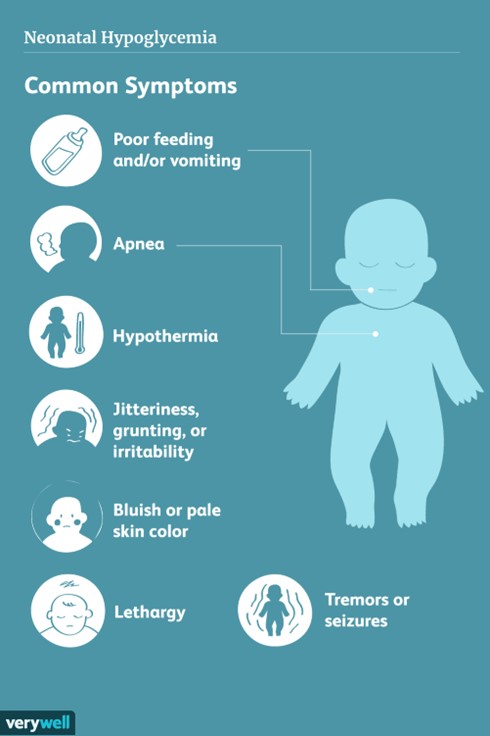What are signs of hypoglycemia in a newborn? Select all that apply.
Tremors
Lethargy
Hunger
Jaundice
Weak cry
Correct Answer : A,B,E

Choice A:
Tremors. This is a sign of hypoglycemia in a newborn because low blood sugar can cause shakiness or jitteriness in the muscles. •
Choice B:
Lethargy. This is a sign of hypoglycemia in a newborn because low blood sugar can cause low energy, poor feeding, or lack of interest in eating.
Choice C:
Hunger. This is not a sign of hypoglycemia in a newborn because low blood sugar can actually reduce the appetite or cause feeding difficulties.
Choice D:
Jaundice. This is not a sign of hypoglycemia in a newborn because jaundice is caused by high levels of bilirubin in the blood, not low levels of glucose.
Choice E:
Weak cry. This is a sign of hypoglycemia in a newborn because low blood sugar can affect the vocal cords and the respiratory system, causing a weak or high-pitched cry.
Nursing Test Bank
Naxlex Comprehensive Predictor Exams
Related Questions
Correct Answer is ["A","C","D","E"]
Explanation
Choice A reason:
Preterm birth is a major risk factor for neonatal sepsis, especially early-onset sepsis. Preterm babies have immature immune systems and lack antibodies to protect them against certain bacteria.
Choice B reason:
Cesarean birth is not a risk factor for neonatal sepsis by itself, unless it is associated with other factors such as prolonged rupture of membranes, maternal infection or chorioamnionitis.
Choice C reason:
Precipitous delivery is a risk factor for neonatal sepsis, especially early-onset sepsis. Precipitous delivery can cause fetal distress, hypoxia, acidosis and increased susceptibility to infection.
Choice D reason:
Frequent vaginal exams are a risk factor for neonatal sepsis, especially early-onset sepsis. Frequent vaginal exams can introduce bacteria into the amniotic fluid and increase the risk of ascending infection.
Choice E reason:
Mother has GBS infection is a risk factor for neonatal sepsis, especially early-onset sepsis. GBS (group B streptococcus) is the most common cause of early-onset neonatal sepsis and can be transmitted from the mother to the baby during labor and delivery.
Correct Answer is B
Explanation
Choice A reason:
This is incorrect because formula-fed newborns typically have one or more stools per day, not every 3 days. Stooling less frequently than once a day may indicate constipation.
Choice B reason:
This is correct because breastfed newborns usually have two to three stools per day, which are soft and yellow. Breastfed babies may also have stools less frequently, even once every 10-14 days, as long as the stool is soft.
Choice C reason:
This is incorrect because newborns should be fed formula on demand, not on a strict schedule. The average feeding interval for formula-fed newborns is about 3 to 4 hours.
Choice D reason:
This is incorrect because newborns should be breastfed eight to 12 times per day, not five to seven times. Breastfeeding more frequently helps to establish milk supply and prevent engorgement. - Stanford Medicine.
Whether you are a student looking to ace your exams or a practicing nurse seeking to enhance your expertise , our nursing education contents will empower you with the confidence and competence to make a difference in the lives of patients and become a respected leader in the healthcare field.
Visit Naxlex, invest in your future and unlock endless possibilities with our unparalleled nursing education contents today
Report Wrong Answer on the Current Question
Do you disagree with the answer? If yes, what is your expected answer? Explain.
Kindly be descriptive with the issue you are facing.
